NZ BusinessNZ manufacturing dropped to 49.7, sector remains in struggle street
New Zealand BusinessNZ Performance of Manufacturing Index dropped from 52.9 to 49.7 in June. Production dropped from 52.6 to 47.8. Employment dropped from 52.8 to 51.2. New orders dropped fro 52.3 to 47.8. Finished stocks dropped from 52.8 to 50.0. Deliveries dropped from 55.1 to 51.7.
BusinessNZ’s Director, Advocacy Catherine Beard said that the drop in activity levels for June highlights the fact that the sector remains in struggle street to get back to long-term activity levels.
“The key sub index values of Production (47.8) and New Orders (47.8) both recorded the same level of contraction, which had a combined negative effect on the overall Index. As mentioned in previous months, a strong and consistent activity level for both these key sub index values will be the only way to push the PMI towards better results.”
European Update: Sterling volatile on Brexit jitters, but still firm
Some volatility is seen in Sterling in European session. It reacted negatively to a DUP lawmaker’s tweet that “Looks like we’re heading for no deal” Brexit. But the Pound was lifted by Brexit Minister Dominic Raab’s thumbs up out of the Cabinet meeting. Sterling is trading generally firm, as the second strongest, just next to Australian Dollar and above New Zealand Dollar. The Aussie is supported by slightly more upbeat RBA statement, after the central bank stood pat on interest rate.
On the other hand, Canadian Dollar, Dollar, and Euro are generally weak. The US calendar is empty today, making way for mid-term election. So volatility could dies down a bit too, until we get the results.
In European markets, at the time of writing:
- FTSE is down -0.66%
- DAX down -0.20%
- CAC down -0.26%
- German 10 year yield drops -0.008 at 0.421
- Italian 10 year yield rises 0.081 to 3.404. Spread is marginally below 300.
In Asia:
- Nikkei rose 1.14% to 22147.75
- Hong Kong HSI rose 0.72% to 26120.96
- China Shanghai SSE dropped -0.23% to 2659.36
- USD/CNH is now above 6.9, as range trading extends
BoC minutes indicate greater confidence in current monetary policy restrictiveness
Summary of BoC’s December 6 meeting showed members collectively agreed “the likelihood that monetary policy was sufficiently restrictive to achieve the inflation target had increased.”
However, members also unanimously agreed that “risks to the inflation outlook remained.” Hence, BoC did not rule out the possibility of further interest rate hikes.
To effectively assess underlying inflationary pressures, BoC members agreed to focus on several key economic indicators. These include the balance of supply and demand in the economy, wage growth, corporate pricing behavior, and inflation expectations.
It’s clarified that while these indicators are not intermediate targets, they “provided helpful information on where inflation is headed.”
Japan Abe: We’ve already compiled a spending package to forestall various risks
Japan Prime Minister Shinzo Abe said today that the government is ready to implement further stimulus measures to offset the impact from coronavirus outbreak. He noted, “we’ve already compiled a spending package to forestall various risks” in the supplementary budget.
“We’ll scrutinize the impact of the coronavirus on the global and Japanese economies. If further steps are deemed necessary, we will take action without hesitation,” he added.
Germany GDP grew 1.5% qoq in Q2, -3.4% below pre-pandemic level
Germany GDP grew 1.5% qoq in Q2, below expectation of 2.0% qoq. Comparing to Q2 2020, GDP was up a price-adjusted 9.6% and a a price- and calendar-adjusted 9.2%. GDP was still -3.4% lower compared to Q2 2019, before the pandemic.
Destatis said, “after the coronavirus crisis had caused another decline in economic performance at the beginning of 2021 (-2.1% in the first quarter, according to most recent calculations), the German economy recovered in the second quarter. This was mainly due to higher household and government final consumption expenditure.”
EU releases proposals on WTO reforms, defend multilateral trade system
European Commission released their comprehensive approach for the modernisation of the World Trade Organisation today.
In presenting the ideas, Commissioner for Trade Cecilia Malmström said: “The multilateral trading system has for the past decades provided a stable, predictable and effective framework for companies across the world, helping many economies to grow rapidly. Also today, the WTO is indispensable in ensuring open, fair and rules-based trade. But despite its success, the World Trade Organisation has not been able to adapt sufficiently to the rapidly changing global economy. The world has changed, the WTO has not. It’s high time to act to make the system able to address challenges of the today’s global economy and work for everyone again. And the EU must take a lead role in that.”
The ideas in the proposal are related to three key ares:
- updating the rule book on international trade to capture today’s global economy
- strengthening the monitoring role of the WTO
- overcoming the imminent deadlock on the WTO dispute settlement system.
EU also noted that the US and Japan are engaged in the framework of trilateral discussions. A dedicated workgroup was set up during the latest EU-China summit. And EU pledged to discuss the ideas with other WTO partners in the coming weeks.
Here is the press release. And a 17-page document detailing the proposals.
Earlier today, the European Union Chamber of Commerce in China released an annual position paper. The 33-page paper detailed 14 common concerns faced by European companies in China, and listed out a accumulative total of 828 recommendations.
This is how adults work!
Shanghai to stop operations until Feb 9, inter-city bus services suspended
China’s Shanghai government announced that the city will not resume operations until February 9, due to coronavirus outbreak in the country. Government operations and private companies will remain closed during the period. Nevertheless, utilities companies and companies that provide medical equipment and pharmaceutical products will continue to work.
Separately announced, the city’s Pudong International Airport will suspend long-distance inter-city bus services to-and-from the airport starting today.
Yuan hit fresh 2-yr low, shrugging PBoC actions
The People’s Bank of China announced yesterday to cut the foreign exchange reserve requirement ratio (RRR) to 6% from 8% beginning September 15. That is, the amount of foreign-exchange deposits banks need to set aside as reserves will be lowered, freeing up funds to buy Yuan.
The move, together with a string of stronger-than expected exchange rate fixings, are seen as a strong signal on PBoC’s stance to at least slow Yuan’s depreciation. That came when Yuan hit fresh two-year low and with USD/CNH approaching psychological important 7 handle.
But USD/CNH’s rally (Yuan’s depreciation) is continuing. There is no sign of topping in USD/CNH as long as 6.8877 support holds, technically. It’s still on track to 61.8% projection of 6.3057 to 6.8372 from 6.7159 at 7.0444.
US initial jobless claims rose to 220k, vs exp 226k
US initial jobless claims rose 1k to 220k in the week ending December 2, below expectation of 226k. Four-week moving average of initial claims rose 500 to 220.75k.
Continuing claims fell -64k to 1861k in the week ending November 25. Four-week moving average of continuing claims rose 7kk to 1872k, highest since December 11 2021.
US oil inventories dropped -2.1m barrels, WTI accelerating as rally resumes
US commercial crude oil inventories dropped -2.1m barrels in the week ending December 31. At 417.9m barrels, oil inventories are about -8% below the give year average for this time of year. Gasoline inventories rose 10.1m barrels. Distillate rose 4.4m barrels. Propane/propylene dropped -0.7, barrels. Total commercial petroleum inventories rose 10.2m barrels.
WTI crude oil rises further after the release, as rally from 62.90 resumed. 100% projection of 62.90 to 73.66 from 66.46 at 77.22 is considered firmly taken out. Further rise is expected as long as 74.48 support holds. WTI is likely in another round of upside acceleration to 161.8% projection at 83.86, which is close to 85.92 high.
For now, we’re not expecting a break of 85.92 yet. We’d expect at least one more down leg before the corrective pattern from there completes. Hence, we’d look for topping between 83.86/85.92. But we’ll see.
BoC Lane: No reason to move in step with Fed, hinting at no rate cut
BoC Deputy Governor Timothy Lane said in a speech enduring uncertainty of US-China trade relations has “already done some damage” to the global and Canadian economy. But “Canada also has notable strengths, and inflation remains on target”. He added, “Our strong labour market points to sources of growth, such as computer system design and other professional services, education, health care and financial services. It is because of this strength amid the turmoil that we say Canada is resilient, although it is not immune.”
Lane also noted Fed has cut interest rate three times this year. But he emphasized “There is no reason for the Bank of Canada to move in step with the Fed. On the contrary, the experience of the past decade shows that Canada and the United States have followed different roads, reflecting differences in our economic conditions.”
The comments reinforced the message from yesterday’s BoC statement. That is, the central is on hold, with a neutral bias.
China confirms Liu He to go to US next week for trade deal signing
Chinese Ministry of Commerce spokesman Gao Feng confirmed that Vice Premier Liu He will travel to Washington next week to sign the first phase of trade agreement with US. Liu will be in US from January 13 to 15 as head of the delegation. Also, he will travel with the titles of Politburo member, vice premier and top trade negotiator.
There are no details regarding the 86-page trade deal yet. US Trade Representative Robert Lighthizer expected the document to be released after signing. One of the mostly concerned part is China’s USD 200B purchases of US goods and services. But Gao declined to comment on the amount of the purchase.
Eurozone CPI finalized at 1.9%, core at 1.0% in November
Eurozone CPI was finalized at 1.9% yoy in November, down from 2.2% yoy in October. Nevertheless, it’s still notable improvement from 1.5% yoy in November 2017. Forex CPI was finalized at 1.0% yoy.
European Union inflation was finalized at 2.0% yoy, down from 2.2% yoy. That compared to 1.8% yoy back in November 2017. Among EU member states, inflation was highest in Romania, Hungary and Estonia at 3.2%. Lowest inflation was recorded in Denmark at 0.7%.
US Empire State manufacturing dropped to 10.5, but Philly Fed survey surged to 32.3
US Empire State Manufacturing index dropped to 10.5 in October, down from 17.0, missed expectation of 16.5. Six months ahead expectation also dropped -7.5 to 32.8.
Philly Fed Manufacturing index, on the other hand, rose sharply to 32.3, up form 15.0, well above expectation of 15.5. it’s the fifth consecutive positive reading after reaching long-term lows in April and May.
CAD rebounds after BoC stands pat, cautious but no dovish turn
Canadian Dollar rebounds after BoC stands pat but doesn’t turn particularly dovish in the statement. The overnight rate target is held at 1.75%. BoC warned that “escalating trade conflicts and related uncertainty are taking a toll on the global and Canadian economies.” Thus, the “current degree of monetary policy stimulus remains appropriate”. The central bank said as it works to upside economic projections, particular attention will be paid to “global developments and their impact”.
On the economy, BoC noted that Q2 was “strong and exceeded” expectation, even though some of this strength is “expected to be temporary”. However, consumption spending was unexpected soft in the quarter while business investment contracted sharply after Q1. “Given this composition of growth, the Bank expects economic activity to slow in the second half of the year.” July CPI was stronger than expected but “largely because of temporary factors”.
Full statement below.
Bank of Canada maintains overnight rate target at 1 ¾ percent
The Bank of Canada today maintained its target for the overnight rate at 1 ¾ percent. The Bank Rate is correspondingly 2 percent and the deposit rate is 1 ½ percent.
As the US-China trade conflict has escalated, world trade has contracted and business investment has weakened. This is weighing more heavily on global economic momentum than the Bank had projected in its July Monetary Policy Report (MPR). Meanwhile, growth in the United States has moderated but remains solid, supported by consumer and government spending. Commodity prices have drifted down as concerns about global growth prospects have increased. These concerns, combined with policy responses by some central banks, have pushed bond yields to historic lows and inverted yield curves in a number of economies, including Canada.
In Canada, growth in the second quarter was strong and exceeded the Bank’s July expectation, although some of this strength is expected to be temporary. The rebound was driven by stronger energy production and robust export growth, both recovering from very weak performance in the first quarter. Housing activity has regained strength more quickly than expected as resales and housing starts catch up to underlying demand, supported by lower mortgage rates. This could add to already-high household debt levels, although mortgage underwriting rules should help to contain the buildup of vulnerabilities. Wages have picked up further, boosting labour income, yet consumption spending was unexpectedly soft in the quarter. Business investment contracted sharply after a strong first quarter, amid heightened trade uncertainty. Given this composition of growth, the Bank expects economic activity to slow in the second half of the year.
Inflation is at the 2 percent target. CPI inflation in July was stronger than expected, largely because of temporary factors. These include higher prices for air travel, mobile phones, and some food items, which are offsetting the effects of lower gasoline prices. Measures of core inflation all remain around 2 percent.
In sum, Canada’s economy is operating close to potential and inflation is on target. However, escalating trade conflicts and related uncertainty are taking a toll on the global and Canadian economies. In this context, the current degree of monetary policy stimulus remains appropriate. As the Bank works to update its projection in light of incoming data, Governing Council will pay particular attention to global developments and their impact on the outlook for Canadian growth and inflation.
Ifo: Coronavirus to cost Germany EUR 255B to EUR 728B
Ifo institute warned that the coronavirus pandemic could cost Germany’s economy between EUR 255B and EUR 729B. President Clemens Fuest said such costs would “exceed everything known in Germany from economic crises or natural disasters in recent decades. ” And, “depending on the scenario, the economy shrinks by 7.2 to 20.6 percent points”.
“If the economy comes to a standstill for two months, depending on the scenario, costs come to between 255 and 495 billion euros. Economic output then shrinks by 7.2 to 11.2 percentage points a year, “says Fuest.
In the best scenario, it is assumed that economic output will decline to 59.6 percent for two months, recover to 79.8 percent in the third month and finally reach 100 percent in the fourth month.
“With three months of partial closure, the costs already reach 354 to 729 billion euros, which is a 10.0 to 20.6 percentage point loss in growth,” says Fuest.
Trump doing well with China, rejects Republican Graham’s deal to reopen government
Trump sounded upbeat on trade negotiation with China today. He told reporters at the White House that “we’re doing very well with China”. And, “I think that we are going to be able to do a deal with China… China wants to negotiate”.
On the other hand, Trump rejected fellow Republican’ Lindsey Graham’s proposal to sign a stopgap spending bill to buy more time for talks on the border wall. Trump said, “I did reject it… I’m not interested. I want to get it solved. I don’t want to just delay it. I want to get it solved”.
US government shutdown is now in the record fourth week as Trumps insists on demanding the funding for border wall.
DOW breaks 55 day EMA, heading back to 25000
DOW opens sharply lower and it’s trading down nearly -900 pts at the time of writing. The strong break of 55 day EMA (now at 27340), and bearish divergence condition in daily MACD, suggests that 29199.35 is at least a short term top. Currently, we’re viewing it as a correction to the rise from 18213.65 first.
Even that case, deeper fall would be seen to 24971.03 cluster support (38.2% retracement of 18213.65 to 29199.35 at 25002.81), which is also close to 25000 psychological level. Reaction from there would tell use whether this assumption of correction is correct, or DOW is indeed reversing the whole move.





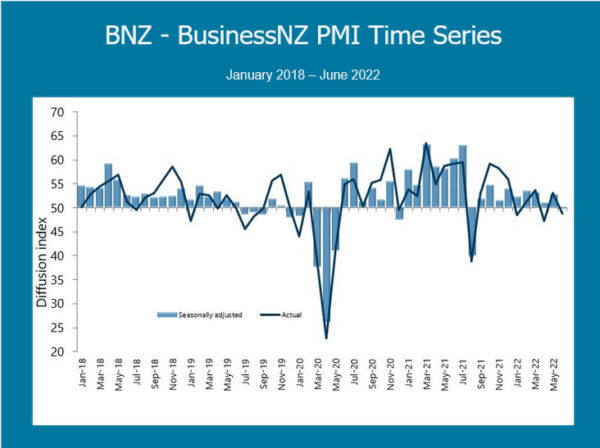
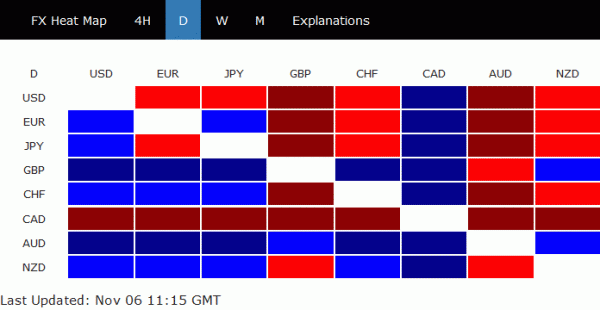
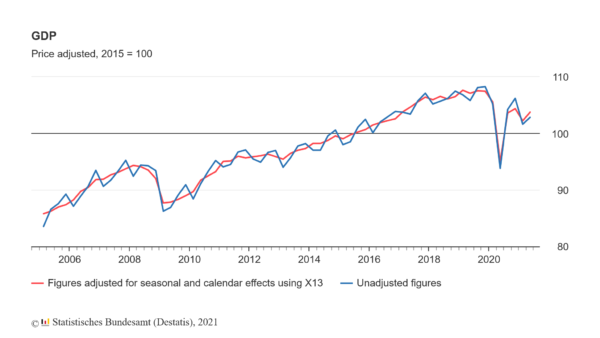
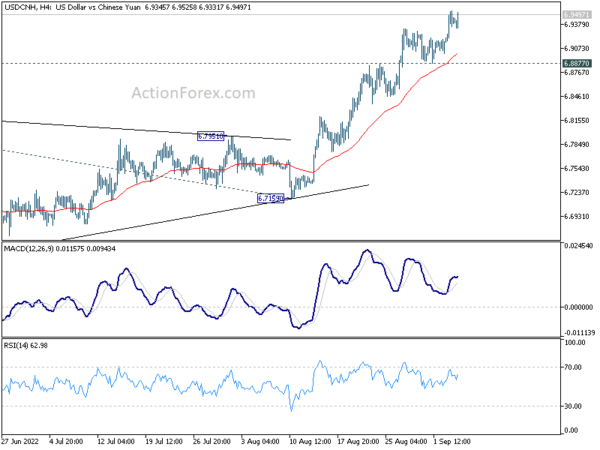

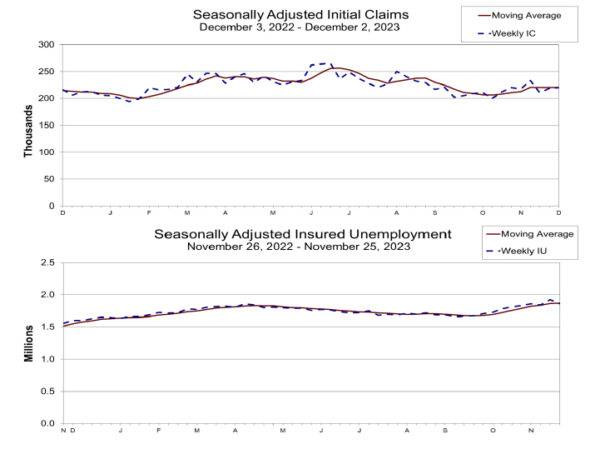
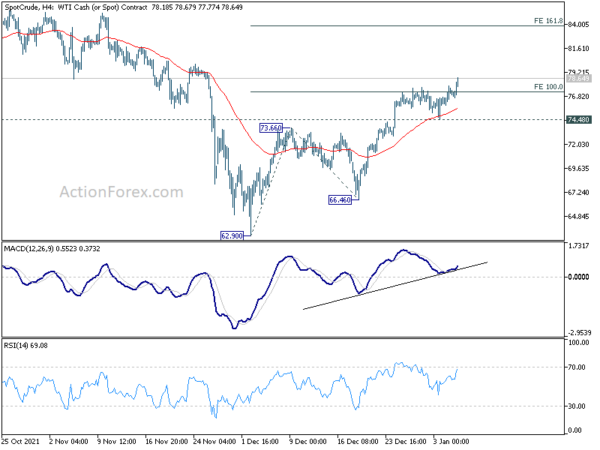
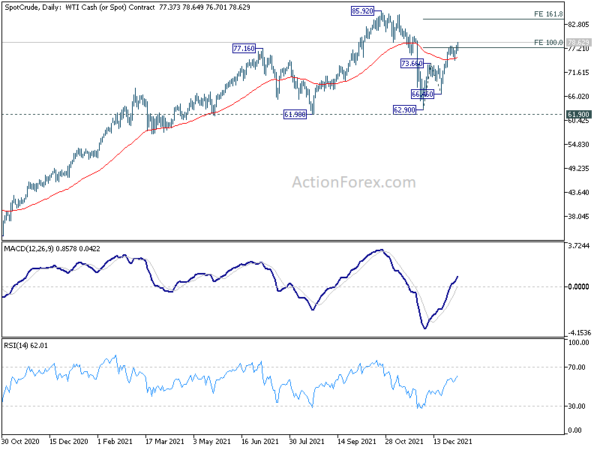
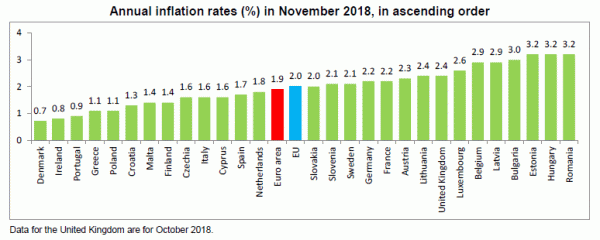
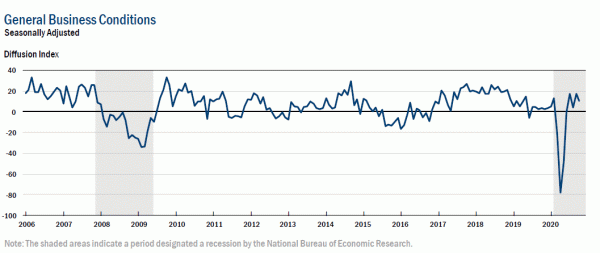
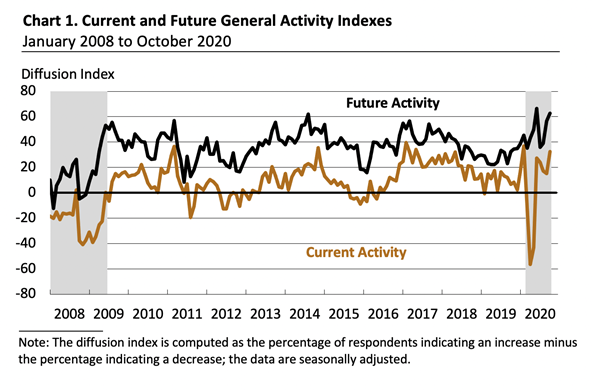
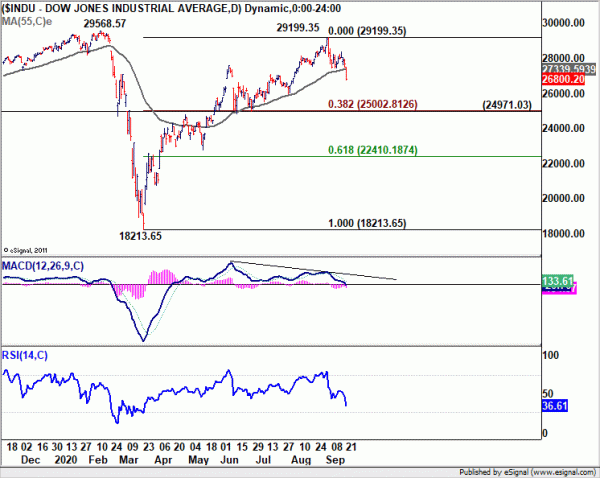

DOW down over 500 pts on debt ceiling and banking worries
Traders are growing increasingly cautious as US stocks open significantly lower today, with selloff gaining momentum throughout the early part of the session. At the time of writing, DOW is down by over -500 points. This decline appears to be a delayed response to Treasury Secretary Janet Yellen’s warning that the department “will be unable to continue to satisfy all of the government’s obligations” as early as June 1, unless Congress raises or suspends the debt limit beforehand. Yellen communicated this warning in a letter to House Speaker Kevin McCarthy. In addition, concerns surrounding regional banks persist, with major bank shares falling by more than -2.5%.
For now, DOW is still holding above near term structural support at 33233.85, which is close to 55 D EMA at 33351.58. The rise from 31429.82 is still intact for extending at a later stage through 34712.28 resistance. Nevertheless, break of 33233.85 will suggest that the corrective pattern from 34712.28 is extending with another falling leg before completion. Let’s see if the deciding move would happen before or after FOMC rate announcement tomorrow.